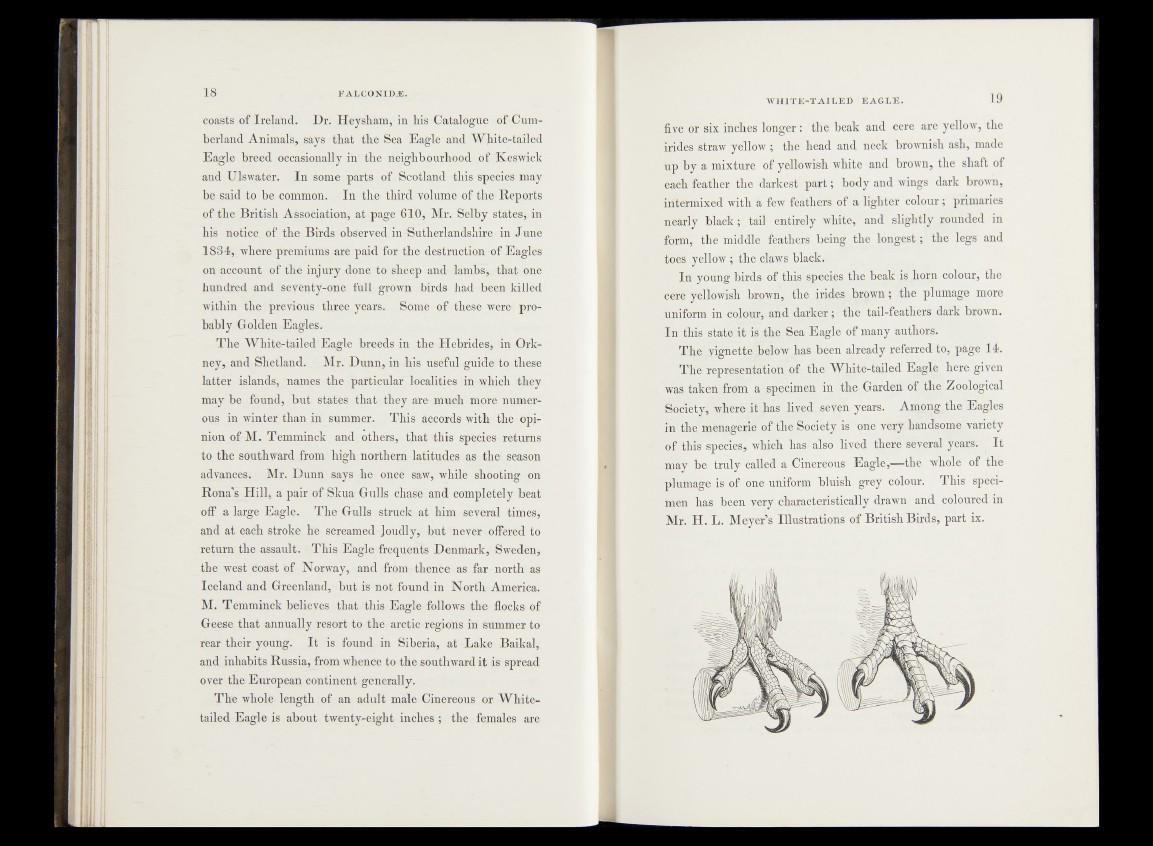
coasts of Ireland. Dr. Hey sham, in his Catalogue of Cumberland
Animals, says that the Sea Eagle and White-tailed
Eagle breed occasionally in the neighbourhood of Keswick
and Ulswater. In some parts of Scotland this species may
be said to be common. In the third volume of the Reports
of the British Association, at page 610, Mr. Selby states, in
his notice of the Birds observed in Sutherlandshire in June
1834, where premiums are paid for the destruction of Eagles
on account of the injury done to sheep and lambs, that one
hundred and seventy-one full grown birds had been killed
within the previous three years. Some of these were probably
Golden Eagles.
The White-tailed Eagle breeds in the Hebrides, in Orkney,
and Shetland. Mr. Dunn, in his useful guide to these
latter islands, names the particular localities in which they
may be found, but states that they are much more numerous
in winter than in summer. This accords with the opinion
of M. Temminck and others, that this species returns
to the southward from high northern latitudes as the season
advances. Mr. Dunn says he once saw, while shooting on
Rona’s Hill, a pair of Skua Gulls chase and completely beat
off a large Eagle. The Gulls struck at him several times,
and at each stroke he screamed Joudly, but never offered to
return the assault. This Eagle frequents Denmark, Sweden,
the west coast of Norway, and from thence as far north as
Iceland and Greenland, but is not found in North America.
M. Temminck believes that this Eagle follows the flocks of
Geese that annually resort to the arctic regions in summer to
rear their young. I t is found in Siberia, at Lake Baikal,
and inhabits Russia, from whence to the southward it is spread
over the European continent generally.
The whole length of an adult male Cinereous or Whitetailed
Eagle is about twenty-eight inches ; the females are
five or six inches longer: the beak and cere are yellow, the
irides straw yellow ; the head and neck brownish ash, made
up by a mixture of yellowish white and brown, the shaft of
each feather the darkest p a rt; body and wings dark brown,
intermixed with a few feathers of a lighter colour; primaries
nearly black; tail entirely white, and slightly rounded in
form, the middle feathers being the longest; the legs and
toes yellow ; the claws black.
In young birds of this species the beak is horn colour, the
cere yellowish brown, the irides brown; the plumage more
uniform in colour, and darker; the tail-feathers dark brown.
In this state it is the Sea Eagle of many authors.
The vignette below has been already referred to, page 14.
The representation of the White-tailed Eagle here given
was taken from a specimen in the Garden of the Zoological
Society, where it has lived seven years. Among the Eagles
in the menagerie of the Society is one very handsome variety
of this species, which has also lived there several years. It
may be truly called a Cinereous Eagle,—the whole of the
plumage is of one uniform bluish grey colour. This specimen
has been very characteristically drawn and coloured in
Mr. H. L. Meyer’s Illustrations of British Birds, part ix.